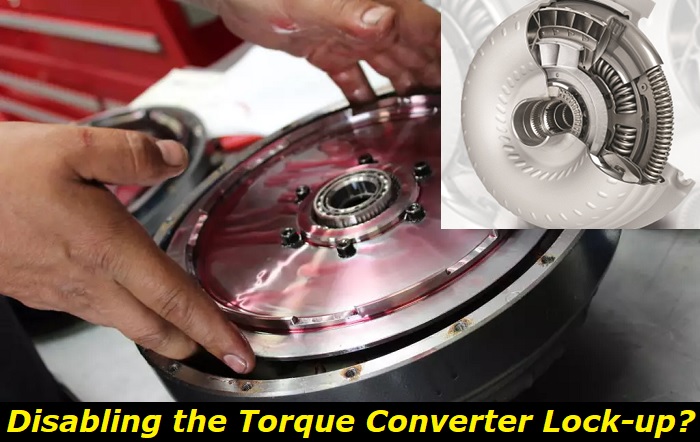You have probably heard of torque converter in a car. If you are a car enthusiast, you have probably heard the raging debate on whether disabling the torque converter lockup is really worth it. In this article, we will take a deeper look at the workings of the torque converter lockup and whether disabling one is worth the effort.

What is a torque converter?
Simply put, a torque converter is a fluid coupling used to transfer power to a rotating driven body. In a car, it is used to transfer rotating power from the car's engine to the transmission. While a manual transmission car uses a clutch, automatic transmission cars use the torque converter.
The torque converter, therefore, sits between the transmission and the engine. It isolates the transmission or the load from the engine when the car stops while ensuring the engine keeps running. This component gives your car more power when accelerating after a complete stop.
After many years of research, trials, and failures, the torque converter today is also responsible for multiplying the torque the car's engine sends out to the transmission. It almost doubles the output torque when the rotational power is low. The torque multiplication allows the fluid from the turbine's vanes to deflect off the stator.
The torque converter has three components, namely:
- The stator
- The impeller
- The turbine
The older torque converters had a problem because there was a disturbance in the oil, and this caused extreme heat. This problem came because there was RPM fluid slippage between the impeller and the turbine. Even after installing vanes on the turbine, the problem persisted since it only managed to cool the oil but ended up wasting a lot of energy and fuel. This partly led to the introduction of the torque converter lockup.
What is torque converter lockup?
A lockup torque converter is simply a torque converter with a clutch. When the lockup torque converter is engaged, it causes the engine to lock to the transmission input shaft. This subsequently means that the drive ratio becomes 1:1. The main reason a lockup torque converter is used is better fuel economy.
For a long time, it was known that manual transmission systems were better in fuel efficiency than automatic transmission. Even though the same is true today, automatic transmission cars are gaining over manual ones. The low fuel efficiency and the loss of RPM pushed for the addition of the 'overdrive,' which helped improve the fuel efficiency of cars. But it was soon discovered that the slippage of the converter created more heat in the transmission. This led to lower fuel efficiency, which meant the overdrive idea was not working as envisioned.
How does the torque converter lockup work?
The torque converter lockup was introduced to address the issues the old torque converters were experiencing. The torque converter lockup works in three stages, namely:
- The stall- When the car stops, but the engine is running, the engine is supplying power to the impeller, but the turbine is not rotating. This happens when the driver applies the brakes, so the car does not move. It is during this period that the maximum multiplication of torque takes place. When you remove your foot from the brake pedal and onto the accelerator, the impeller starts moving faster to set the turbine in motion. The impeller speed is much higher than that of the turbine.
- The acceleration- When accelerating, the turbine speed keeps increasing. However, there is still a big difference between the impeller and the turbine speed. As the turbine speed increases, the torque multiplication keeps reducing.
- Coupling- The turbine's speed will increase until it reaches 90% of the impeller's speed. At this point, the torque multiplication reduces to zero. The converter will now behave just like a simple fluid coupling.
During coupling, the lockup clutch comes into play and will lock the turbine to the impeller. This means that the impeller and the turbine move at the same speed. It is worth noting that the lockup clutch engages upon the coupling point being achieved. The stator will start rotating in the direction of the turbine and impeller rotation during coupling.
The turbine in the lockup converter locks the hydraulic pressure whenever the crankshaft and the input shaft turn simultaneously while driving. Whenever the lockup clutch is engaged, the fluid in the torque converter rotates at the same speed as the other converter components. When this happens, the oil turbulence and heat are curtailed significantly.
It is also worth noting that the lockup mechanism causes the converter's components to act as a rotating flywheel mass. This consequently means that the load on the radiator is significantly reduced hence ensuring better fuel economy for your car.
Torque converter lockup problems
There are times when the torque converter lockup might fail, and there are several different ways in which it can. Some of the issues can even lead the engine to stall. It is, therefore, essential to understanding these problems before you get to decide whether to disable the lockup or not.
- The torque converter lockup can fail to unlock. This leads to the engine stalling when you brake the car.
- When the lockup clutch remains open and does not lock even when the fluid in the converter and the converter components rotate at the same speed, there will be excess radiator temperature. This problem also leads to excess fuel consumption.
- The torque converter lockup tends to slip even when engaged. This leads to the engine speed increasing. It has been suggested on several online forums that the lockup issues can be caused by glycol contamination.
How to disable the torque converter Lockup
Because of the problems some drivers encounter because of the torque converter lockup, some decide to do some modifications to their cars whereby the lockup is forced to stay open. While the diagnostics machine will pinpoint the problem of a torque converter lockup, not opening, it is important to note that keeping it open only serves as a diagnostic solution, not a permanent one.
To disable the lockup, mechanics modify the torque converter lockup to keep it open and then place a switch inside the car. This switch helps keep the lockup open while cruising. The easiest route is to block the solenoid mechanically, forcing the lockup to remain open. This process ensures that the car's RPM doesn't fluctuate anymore when coasting. The engine will no longer suffer from hesitation and no abrupt engine stalling.
Does disabling the torque converter lockup help?
It is generally agreed that forcing the torque converter lockup to remain open or disabled is just but a diagnostic routine for an underlying problem. You always have to remember to press the installed switch or rather unlock it every time you come to a stop. This can be tedious, and you will likely forget sooner or later.
Forgetting to unlock the switch when you come to a stop means the engine will stall, and this will lead to the clutch getting burned. It is like driving a manual car; when stopping, you fail to press the clutch pedal. This means the engine is engaged to the transmission, which leads to stalling.
It is worth noting that a torque converter lockup ensures that the car idles without the risk of stalling. The converter has a set stall speed, which will break every time the drive connection between the transmission and the engine, and this happens when the engine reaches a certain RPM level. That's why you always must remember to press your disabling lockup switch when required.
Continued driving of your car with a disabled lockup leads to the following:
- Permanently disabling the lockup torque converter will mean more wear and tear on the converter and transmission parts.
- You will start noticing the cruising RPM to be exceedingly higher.
- The transmission overheating
- Burning of the torque converter lockup clutch. This happens when you forget to activate the lockup when coming to a stop. This is especially the case where there is a lot of stop-and-go traffic.
Conclusion
The torque converter lockup can have problems that will make your car misbehave. Finding the correct remedy to the problem is crucial to avoid escalating the issue, which may include damage to the transmission or even the engine. While disabling the lockup has been seen to work, it is only a temporary solution.
The solution to the torque converter lockup issues is to use the diagnostic machine and establish precisely what is ailing your car. Disabling the component might work for a short while, but this makes the problem worse in the long run. In other cases, drivers have replaced the component only for the lockup issue to persist. This is why the solution to this problem lies with the proper diagnosis. As an informed driver, you will know that replacing the torque converter lockup is the way to go, and disabling the unit increases the risk of encountering more issues.
About the authors
The CarAraC research team is composed of seasoned auto mechanics and automotive industry professionals, including individuals with advanced degrees and certifications in their field. Our team members boast prestigious credentials, reflecting their extensive knowledge and skills. These qualifications include: IMI: Institute of the Motor Industry, ASE-Certified Master Automobile Technicians; Coventry University, Graduate of MA in Automotive Journalism; Politecnico di Torino, Italy, MS Automotive Engineering; Ss. Cyril and Methodius University in Skopje, Mechanical University in Skopje; TOC Automotive College; DHA Suffa University, Department of Mechanical Engineering






Add comment